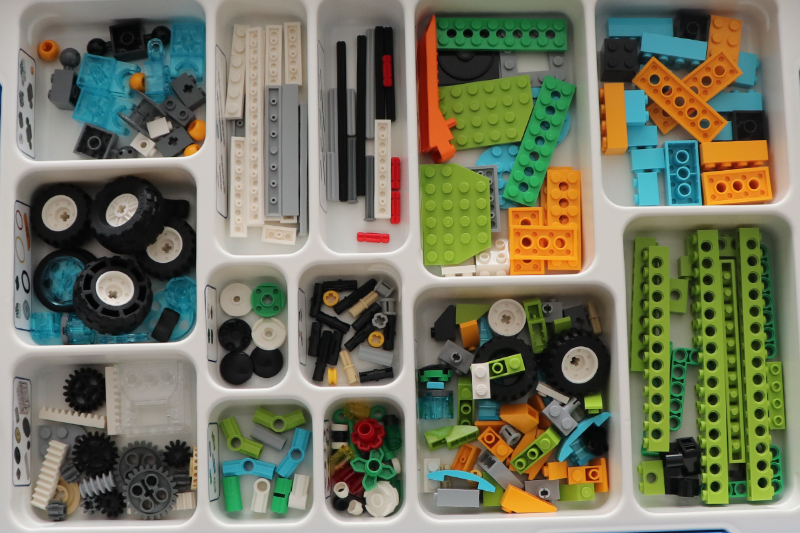We are going to take a look at Lego’s Wedo 2,0 and see how you could use it in your classroom, Learning commons or alternative educational space. Thanks to Spectrum Nasco Educational Supplies for supplying the Lego WeDo 2.0 for this article and video.
What is Lego WeDo 2.0?
According to Lego:
"LEGO Education WeDo 2.0 Core Set is a hands-on STEM solution that combines the LEGO brick, classroom-friendly software, engaging standards-based projects and a discovery based approach. Designed with collaboration in mind, each Core Set supports two students, introducing them to computational thinking and engineering principles in a fun and engaging way." Source: https://education.lego.com/en-us/products/lego-education-wedo-2-0-core-set/45300
So what does that mean? For those of you who are new to education based robotics it means its a typical lego set with has a couple of new components:
- A Brain: the Lego WeDo 2.0 kit has a brain called a 'smart hub'. The smart hub connects to a computer/tablet via Bluetooth or cable and can download code to perform any operation (with the confines of the WeDo software). The smart hub has two I/O ports to control the motor and two sensors.
- Power Pack: The Lego WeDo 2.0 kit comes with a battery pack that requires 2 x AA batteries to operate the smart hub. It is recommended if you are purchasing a WeDo 2.0 kit that you purchase the rechargeable battery back. Be sure to order the WeDo 2.0 Power Pack Add-On which includes the battery and the charger. Here is the link to that product https://spectrum-nasco.ca/product-730745.
- A Motor: each Lego WeDo 2.0 kit comes with a motor that allows the kits to move. You can program the hub to control the motor and adjust variables. The motor included in the kit is a "medium" motor. This motor can operate clockwise (forward) and counterclockwise (backward). You can order additional motors if you want to build more complicated things.
- Motion Sensor: The motion sensor is an included sensor that you can add to your Lego WeDo 2.0 build. The sensor will detect objects up to 15 cm away. This sensor is automatically detected when it is plugged into the smart hub.
- Tilt Sensor: This is the second sensor included in your Lego WeDo 2.0 kit. The tilt sensor can detect six (6) different positions and is automatically detected by the smart hub.
Of course, on top of all of the above, you get a whole bunch of regular lego bricks, axles, wheels, belts (for the motor), etc. The kit comes out of the box with everything you would need to get started building robotics projects.
A Word About Software:
Lego WeDo 2.0 has a software interface you can download for Windows (7, 8.1, 10), MacOS, Chromebook, iPad (iOS), and Android. We tested the MacOS (desktop) and iPad (iOS) versions.
In our brief testing period, we found that we preferred the desktop software over the iPad tablet software. The issue we found with the iPad software was that the scroll at the bottom of the programming canvas was a bit unresponsive at times.
The Interface:
The Lego WeDo 2.0 software interface is intuitive and fairly easy to use. Once you have launched the software you are presented with several options:
- Teacher Resources: When you click this link you will be taken to the WeDo 2.0 Teacher Guides website. Here you can find resources like guides for science teachers, computational teachers, toolkits, etc. Unfortunately, there aren't specific teacher Canadian guides available. For English guides, you are able to choose between the US, British and Australian versions. There is a french (France) guide you can use. The guides are fairly detailed, but for beginners, the toolkit seems to be the most useful. The toolkit breaks down how to use WeDo 2.0 step by step. It outlines the coding blocks and how to use them.
- Lesson Plans (Under Teacher Resources): The lesson plans link will take you to the Lego Education website where you will be presented with a whole bunch of lesson plans. The default lesson plans will be US-based (there aren't any Canadian based lesson plans as of yet). They will give you grade level, skill level (beginner, intermediate, or advanced) and subject matter as it relates to the curriculum. The projects included in 'My First Project' are there as well as a whole host of other projects.
- Classroom Resources: This section of the software gives you some direction as to a set of rules to create with your class while using WeDo 2.0.
- My First Project: This section of the software will give you some projects to get started. It has eight (8) 'Getting Started' projects that are a great jumping-off point for students. Each project in this section has an introduction with Lego characters named Max and Mia. Max and Mia will walk you through the project from start to finish. There are several additional projects underneath the getting started projects that are broken down into the following areas:
- Guided Projects - Science
- Open Projects - Science
- Guided Projects - Computational Thinking
- Open Projects - Computational Thinking
- My Projects: My projects are simply a list of all the projects that have been worked on. The program autosaves your projects as students work.
Projects We Built:
We built a couple of projects with our WeDo 2.0. The first project was the "Speed" project. Essentially you are building a race car. Once the car is built you can change variables, like wheel size, to see how it affects the speed of the car. The car was a great first project to start with. The second project I gave to a pair of Grade 1 and a Grade 2 boys, who happen to be my nephews. They built "Milo the Science Rover" with very little help. You can see them working in our WeDo 2.0 vlog. The fact the projects are Lego-based makes it familiar and easy for students to get started. My nephews followed the graphical instructions for the project and were able to successfully build and code the rover. They were excited to build it and make it go.
Quick Facts:
- The Lego WeDo 2.0 kit is intended for grade levels 2 - 4.
- Each kit would be ideally shared between 2 students.
- The Lego WeDo 2.0 kit is priced around $260 https://spectrum-nasco.ca/product-730432.
- It is recommended that you order the Power Pack Add-On rechargeable battery kit. It is priced around $100 https://spectrum-nasco.ca/product-730745.
Bottom Line:
I really enjoyed exploring the Lego WeDo 2.0 Kit. It was interesting, easy to get started with, but challenging enough to keep things interesting. I felt that the software interface was well laid out. The available resources were rich enough to keep students interested and busy.
Pros
|
Cons
|
Have a suggestion for a topic you would like to see covered on LearnTechGuy.com? Visit our make a suggestion page and we will do our best to honour your request!
Thanks to Spectrum Nasco Educational Supplies for supplying the Lego WeDo 2.0 kit
Disclaimer: I am not a teacher. I just really into educational technology. I have been provided with the Lego WeDo 2.0 kit from Spectrum Nasco Educational Supplies free of charge to demo and experiment with. All the opinions are my own and are not the views of any suppliers or manufacturers.
















